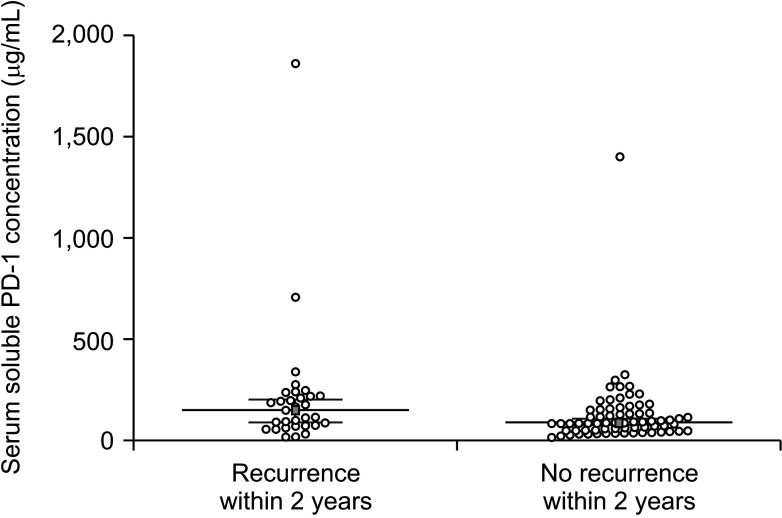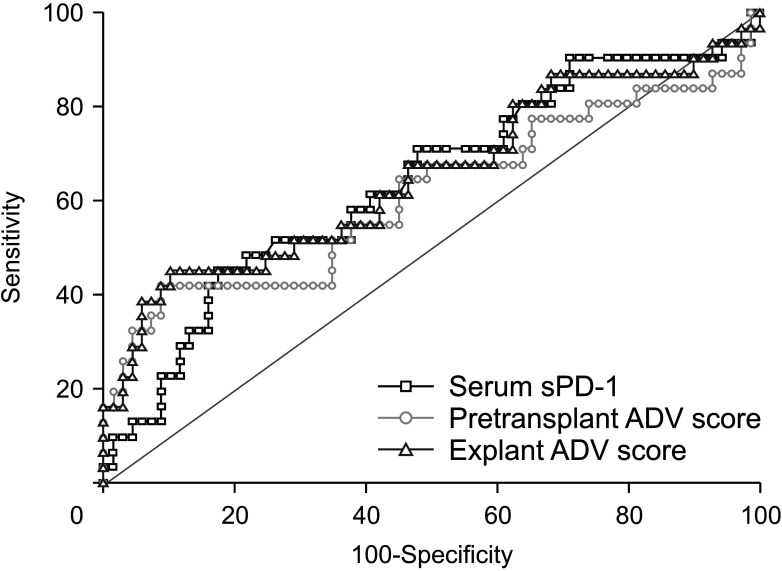Ann Surg Treat Res.
2022 Jan;102(1):46-54. 10.4174/astr.2022.102.1.46.
Prognostic impact of serum soluble PD-1 and ADV score for living donor liver transplantation in patients with previously untreated hepatocellular carcinoma
- Affiliations
-
- 1Division of Hepatobiliary Surgery and Liver Transplantation, Department of Surgery, Asan Medical Center, University of Ulsan College of Medicine, Seoul, Korea
- 2Asan Institute of Life Sciences, Asan Medical Center, University of Ulsan College of Medicine, Seoul, Korea
- KMID: 2523769
- DOI: http://doi.org/10.4174/astr.2022.102.1.46
Abstract
- Purpose
The programmed death protein 1 (PD-1) pathway is the critical mechanism in development of hepatocellular carcinoma (HCC). The present study analyzed the prognostic impact of pretransplant serum soluble PD-1 (sPD-1) concentration and α-FP–des-γ- –tumor volume (ADV) score in patients with previously untreated HCC undergone liver transplantation (LT).
Methods
This retrospective single-center study enrolled 100 patients with HCC who underwent living donor LT from 2010 to 2016. Concentrations of sPD-1 were measured in stored serum samples.
Results
Receiver operating characteristic curve analysis of 2-year tumor recurrence resulted in an sPD-1 cutoff of 177.1 µg/mL, which was associated with higher rates of tumor recurrence (P = 0.022), but not with overall patient survival (P = 0.460). The derived cutoff for pretransplant ADV score was 5.4log, which was associated with higher tumor recurrence rate (P < 0.001) and lower overall patient survival rate (P < 0.001). Both sPD-1 of >177.1 µg/mL (hazard ratio [HR], 2.26; P = 0.020) and pretransplant ADV score of >5.4log (HR, 3.56; P < 0.001) were independent risk factors for posttransplant HCC recurrence. The combination of these 2 factors enabled the stratification of patients into 3 groups, with groups having 0, 1, and 2 risk factors differing significantly in the prognosis of tumor recurrence (P < 0.001) and overall patient survival (P = 0.006).
Conclusion
Both sPD-1 concentration and ADV score have prognostic impacts in patients who underwent LT for untreated HCCs. These factors, both individually and combined, can help in predicting posttransplant prognosis.
Figure
Cited by 1 articles
-
ADV score is a reliable surrogate biomarker of hepatocellular carcinoma in liver resection and transplantation
Shin Hwang, Dong-Hwan Jung, Gi-Won Song
Ann Liver Transplant. 2023;3(2):86-93. doi: 10.52604/alt.23.0023.
Reference
-
1. Mazzaferro V, Regalia E, Doci R, Andreola S, Pulvirenti A, Bozzetti F, et al. Liver transplantation for the treatment of small hepatocellular carcinomas in patients with cirrhosis. N Engl J Med. 1996; 334:693–699. PMID: 8594428.
Article2. Yao FY, Ferrell L, Bass NM, Watson JJ, Bacchetti P, Venook A, et al. Liver transplantation for hepatocellular carcinoma: expansion of the tumor size limits does not adversely impact survival. Hepatology. 2001; 33:1394–1403. PMID: 11391528.3. Lee SG, Hwang S, Moon DB, Ahn CS, Kim KH, Sung KB, et al. Expanded indication criteria of living donor liver transplantation for hepatocellular carcinoma at one large-volume center. Liver Transpl. 2008; 14:935–945. PMID: 18581465.
Article4. Mazzaferro V, Sposito C, Zhou J, Pinna AD, De Carlis L, Fan J, et al. Metroticket 2.0 model for analysis of competing risks of death after liver transplantation for hepatocelular carcinoma. Gastroenterology. 2018; 154:128–139. PMID: 28989060.5. Hwang S, Song GW, Ahn CS, Kim KH, Moon DB, Ha TY, et al. Quantitative prognostic prediction using ADV score for hepatocellular carcinoma following living donor liver transplantation. J Gastrointest Surg. 2021; 25:2503–2515. PMID: 33532981.
Article6. Hwang S, Song GW, Ahn CS, Kim KH, Moon DB, Ha TY, et al. Salvage living donor liver transplantation for hepatocellular carcinoma recurrence after hepatectomy: quantitative prediction using ADV score. J Hepatobiliary Pancreat Sci. 2021; 28:1000–1013. PMID: 33175453.
Article7. Jung DH, Hwang S, Song GW. Selection criteria of living donor liver transplantation for hepatocellular c arc inoma developed in Korean transplant centers. Ann Liver Transplant. 2021; 1:29–47.8. Hwang S, Song GW, Lee YJ, Kim KH, Ahn CS, Moon DB, et al. Multiplication of tumor volume by two tumor markers is a post-resection prognostic predictor for solitary hepatocellular carcinoma. J Gastrointest Surg. 2016; 20:1807–1820. PMID: 27311982.
Article9. Jung DH, Hwang S, Lee YJ, Kim KH, Song GW, Ahn CS, et al. Small hepatocellular carcinoma with low tumor marker expression benefits more from anatomical resection than tumors with aggressive biology. Ann Surg. 2019; 269:511–519. PMID: 28837444.
Article10. Park GC, Hwang S, Park YH, Choi JU. Korean Liver Cancer Study Group. Validation of prognostic impact of ADV score for resection of hepatocellular carcinoma: analysis using Korea Liver Cancer Registry Database. Ann Surg Treat Res. 2020; 98:235–246. PMID: 32411628.
Article11. Zou W, Wolchok JD, Chen L. PD-L1 (B7-H1) and PD-1 pathway blockade for cancer therapy: mechanisms, response biomarkers, and combinations. Sci Transl Med. 2016; 8:328rv4.
Article12. Chang B, Huang T, Wei H, Shen L, Zhu D, He W, et al. The correlation and prognostic value of serum levels of soluble programmed death protein 1 (sPD-1) and soluble programmed death-ligand 1 (sPD-L1) in patients with hepatocellular carcinoma. Cancer Immunol Immunother. 2019; 68:353–363. PMID: 30506460.
Article13. Gao Q, Wang XY, Qiu SJ, Yamato I, Sho M, Nakajima Y, et al. Overexpression of PD-L1 significantly associates with tumor aggressiveness and postoperative recurrence in human hepatocellular carcinoma. Clin Cancer Res. 2009; 15:971–979. PMID: 19188168.
Article14. Chang B, Shen L, Wang K, Jin J, Huang T, Chen Q, et al. High number of PD-1 positive intratumoural lymphocytes predicts survival benefit of cytokine-induced killer cells for hepatocellular carcinoma patients. Liver Int. 2018; 38:1449–1458. PMID: 29356308.
Article15. Na BG, Kim YK, Hwang S, Lee KJ, Park GC, Ahn CS, et al. Absence of association between pretransplant serum soluble programmed death protein-1 level and prognosis following living donor liver transplantation in patients with hepatocellular carcinoma. Medicine (Baltimore). 2021; 100:e25640. PMID: 33907121.
Article16. Shrestha R, Prithviraj P, Anaka M, Bridle KR, Crawford DH, Dhungel B, et al. Monitoring immune checkpoint regulators as predictive biomarkers in hepatocellular carcinoma. Front Oncol. 2018; 8:269. PMID: 30057891.
Article17. Wang BJ, Bao JJ, Wang JZ, Wang Y, Jiang M, Xing MY, et al. Immunostaining of PD-1/PD-Ls in liver tissues of patients with hepatitis and hepatocellular carcinoma. World J Gastroenterol. 2011; 17:3322–3329. PMID: 21876620.
Article18. Shi F, Shi M, Zeng Z, Qi RZ, Liu ZW, Zhang JY, et al. PD-1 and PD-L1 upregulation promotes CD8(+) T-cell apoptosis and postoperative recurrence in hepatocellular carcinoma patients. Int J Cancer. 2011; 128:887–896. PMID: 20473887.
Article19. Kim HD, Song GW, Park S, Jung MK, Kim MH, Kang HJ, et al. Association between expression level of PD1 by tumor-infiltrating CD8+ T cells and features of hepatocellular carcinoma. Gastroenterology. 2018; 155:1936–1950. PMID: 30145359.
- Full Text Links
- Actions
-
Cited
- CITED
-
- Close
- Share
- Similar articles
-
- ADV score is a reliable surrogate biomarker of hepatocellular carcinoma in liver resection and transplantation
- Very high serum soluble PD-1 is closely associated with hepatocellular carcinoma recurrence after liver transplantation
- Venous outflow congestion is related to poor recurrence-free survival of living donor liver transplantation recipients with hepatocellular carcinoma
- Liver Transplantation for Hepatocellular Carcinoma
- Predictors of postrecurrence survival in hepatocellular carcinoma patients after living donor liver transplantation







